Mastering how to discipline a Bulldog can be challenging, especially with their early-set nature and stubborn traits. Despite the myriad of stereotypes, the right approach can transform your Bulldog puppy into a well-behaved companion.
To discipline a Bulldog, start training your Bulldog early by establishing leadership and trust. Use clear “No!” commands, redirect bad behavior, and reward good actions. Opt for non-aggressive punishments like time-outs to maintain discipline without causing defensiveness.
Let’s dive into effective discipline strategies for Bulldogs, ensuring a harmonious relationship with your furry friend.
Key Takeaways
- Be Consistent: Regular routines and consistent commands are essential for training your Bulldog effectively.
- Use Positive Reinforcement: Treats and praise are more effective than punishment for encouraging good behavior in Bulldogs.
- Stay Patient: Bulldogs’ stubbornness demands patience; persistent, gradual training leads to better discipline.
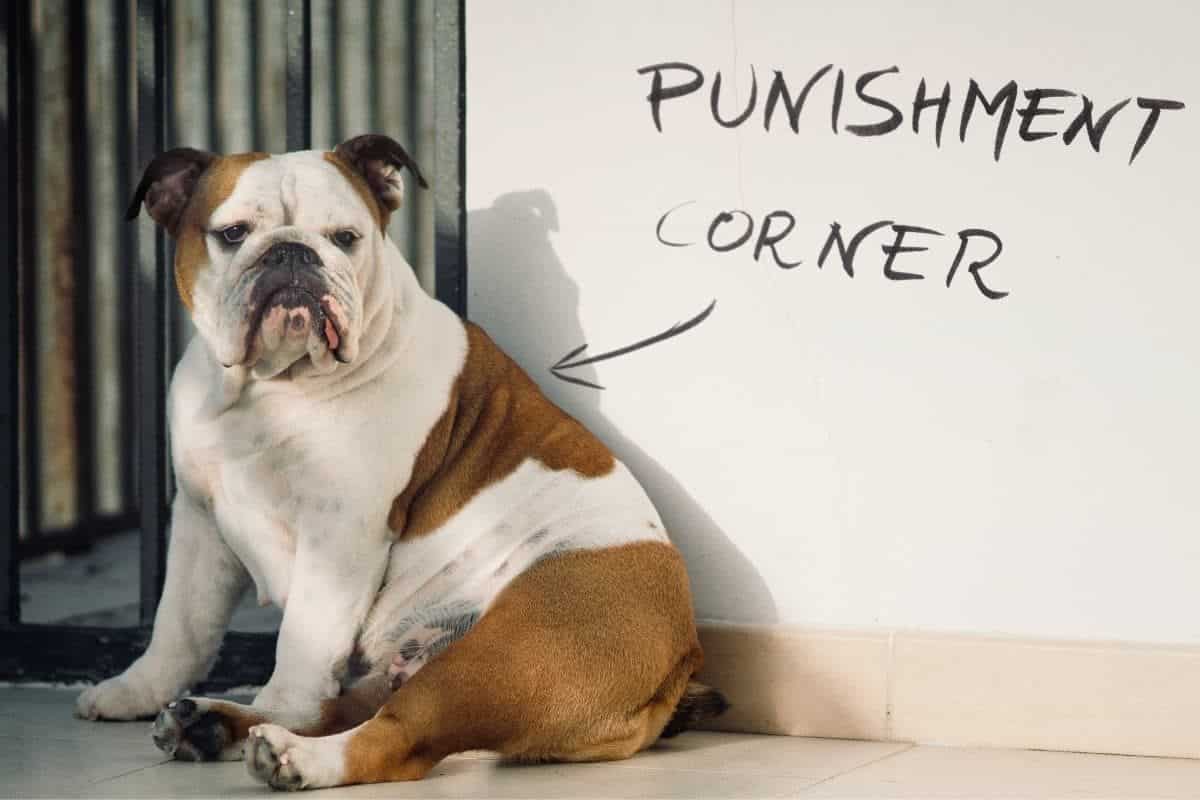
Tips for Successful Discipline
Here is a tabled view of what to do and what not to do when training your dog.
| Take the long-term view | Disciplining a Bulldog: The Don’ts |
|---|---|
| Start early – from 8 weeks old | Don’t start too late |
| Establish yourself as the leader and build trust | Don’t push too much |
| Be calm and consistent – yet assertive | Don’t use force |
| Take the long term view | Don’t yell with excessive eye contact |
| Train the “NO!” command | Don’t make your Bulldog defensive |
| Distract and redirect bad behavior | Don’t be too passive |
| Use positive reinforcement | Don’t discipline too late |
| Ignore demanding behavior | Don’t use discipline to get even |
| Use time-outs effectively | Don’t encourage bad behavior |
How to Discipline a Bulldog: The Do’s
Bulldogs can be disciplined and well-adjusted not just into families but also neighborhoods.
This requires a lot of patience and an early start, two things that are important enough to introduce right away as we discuss what you must do to get your dog to behave properly.
Each “Do” in this section benefits from your patience and a timely start. That said, not everything must be started early; consulting with a Bulldog puppy training schedule is essential.
The overall training, however, must be started as soon as the dog reaches your home.
How To Discipline Your Puppy…
1. Start Training Early
Bulldog training should start at eight weeks old. Although they have short attention spans at this young age, they are quite capable of learning basic commands such as “SIT,” “NO,” “DOWN,” “LOOK AT ME,” and “LEAVE IT.”
Keep training sessions short; start with 2-3 minutes and work up, but repeat 5-6 times throughout the day. This prevents your pup from being overwhelmed.
Puppy socialization is equally as important.
This means exposing your English Bulldog to different sights, smells, noises, people, children, dogs, and other animals. Socialization is key to having a well-behaved dog, as he won’t be fearful in new situations.
While you should start training your Bulldog as soon as you bring him home, don’t worry, as you can still train an older dog. However, be aware that it may take a little longer for your dog to learn, depending on his age.
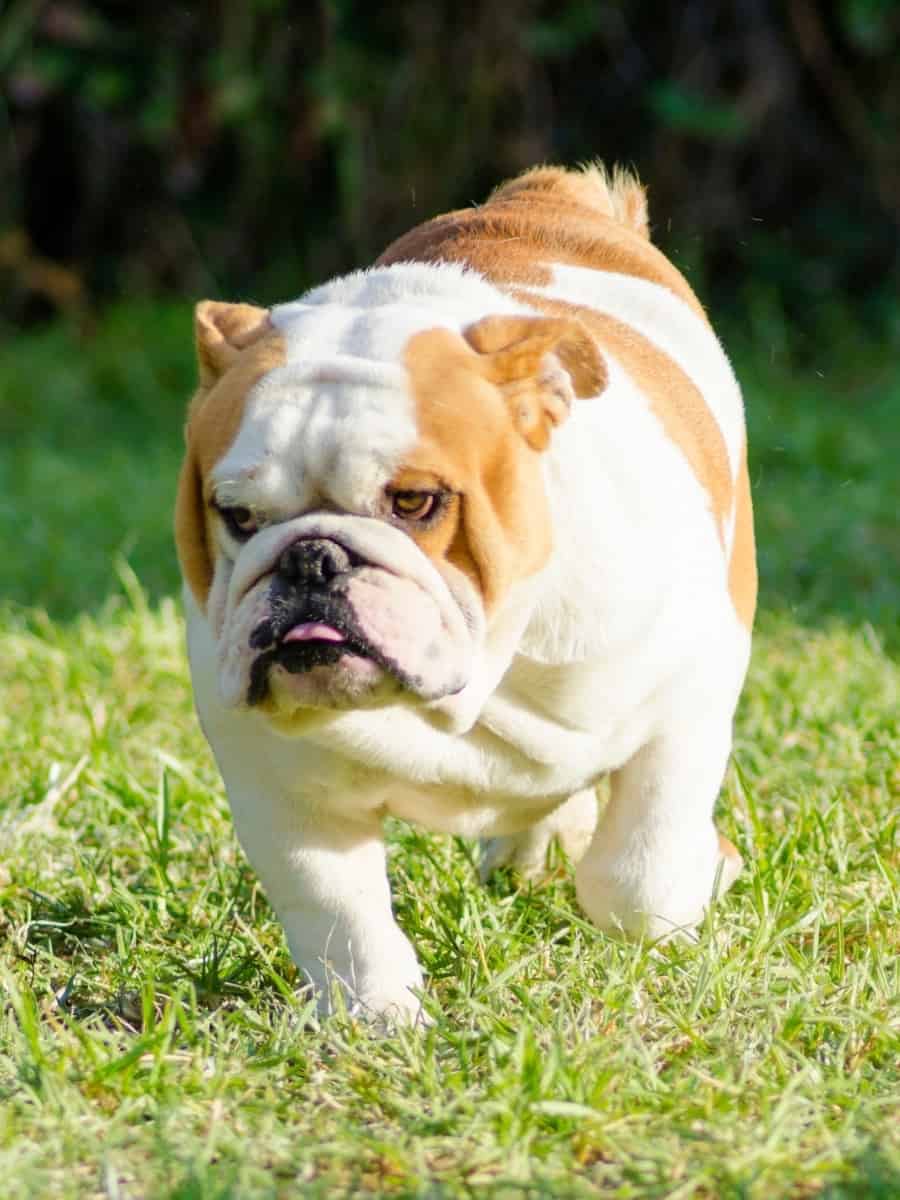
2. Establish Yourself as the Leader and Build Trust
Be firm and be the leader of the pack. If you use the correct tone without yelling, your Bulldog will quickly learn to see you as the authority. This also builds trust with your dog and solidifies the bonding process.
If you are nervous or timid, your dog will sense these emotions. I made another mistake in my early days of training my dog, who clearly picked up on my nervousness during his early socialization with other dogs.
As communication is a two-way process, learn your Bulldog’s body language so you can better understand him.
If you make learning fun, your Bulldog will respond much more quickly. If you find that your pup is easily distracted, change the environment to a quiet one, and as you progress, you can increase distractions.
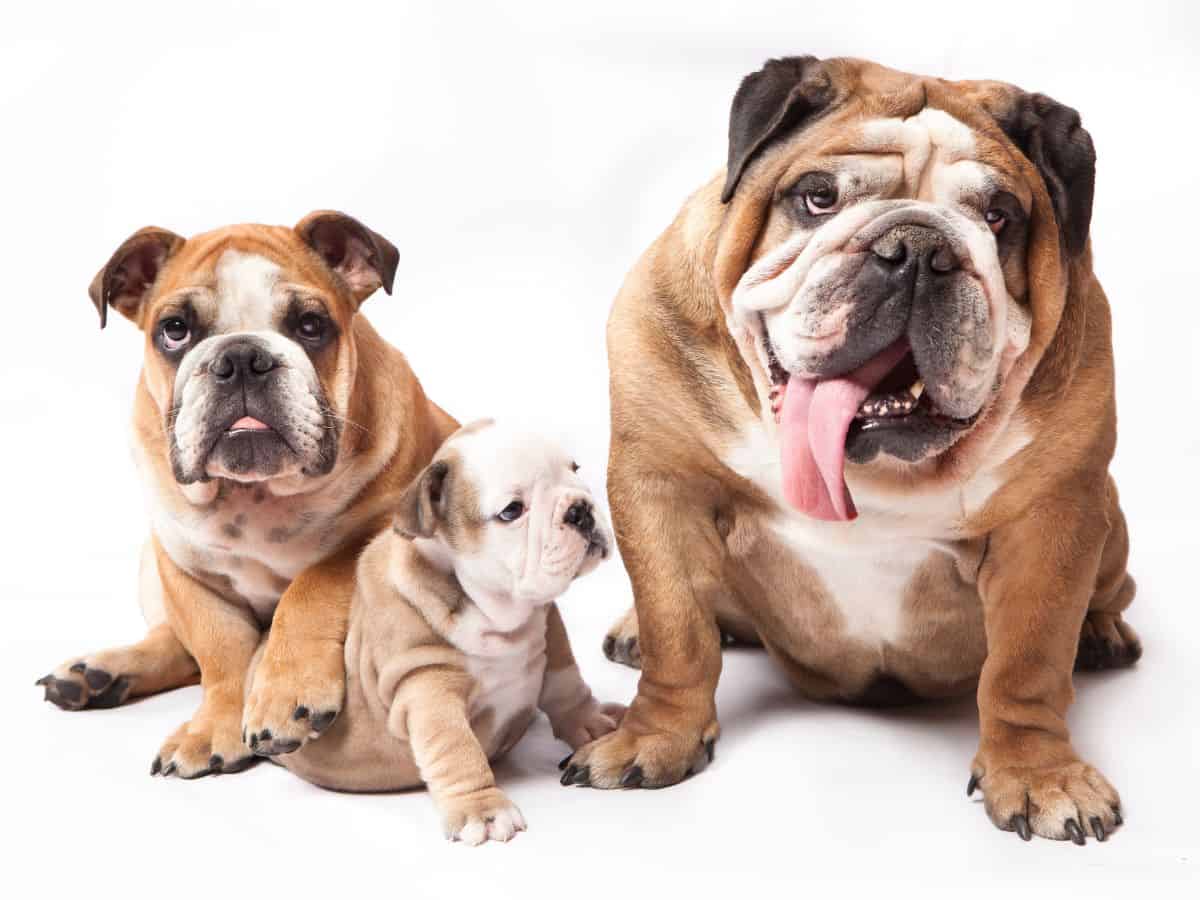
3. Be Calm and Consistent – Yet Assertive
Being a responsible Bulldog owner is like taking a masterclass in being calm. Your dog learns from you, and you can turn him into a gentle giant if you turn yourself into one (gentle; the giant part is optional).
Be assertive when you command or tell him off, but remain calm.
It’s also important to remain consistent. For example, if you don’t allow your Bulldog on your bed yet allow him on Sundays, this inconsistency with your teaching will only confuse him.
Ensure all family members teach the same, too, such as using exactly the same verbal commands. It’s no good if you use the command “WAIT” and someone else uses “STOP!”
4. Take the Long-Term View
They say, “you can never teach an old dog new tricks.” With Bulldogs, the tricks themselves get old by the time your Bulldog gets them.
Every step, every lesson, and every direction is a long-term lesson. You cannot expect your Bulldog to pick up everything immediately.
This is another indicator that you must start early because your dog will lag if you delay his training.
When it comes to raising the perfect dog and socially acceptable dog etiquette, if your dog lags, he might be shunned by canine peers, making it difficult to reintegrate him into the neighborhood dog community.
5. Train the “NO!” Command
English Bulldogs are not to be physically restrained as you only give them strength training and incentive to overpower you when you do so.
Teach your Bulldog to be disciplined by training him to stop anything he does with a firm “NO” command.
For all commands, you build an association when your dog is doing something and you say the word.
This repetition can anchor the command. For instance, with fetch, you can say the word “FETCH” when he’s chasing a stick. You can also say “GO” when you release him, associating the sprint with the word “GO.”
One point to consider is never to use the “NO” command when your dog approaches you. His walking up to you is sacred. Do not mess with this, as it will introduce confusion with your “COME” command.
Some dog owners use the “COME” command when a dog messes up and then punish him for the mess. This, again, only discourages the dog from accepting and following the “COME” command.
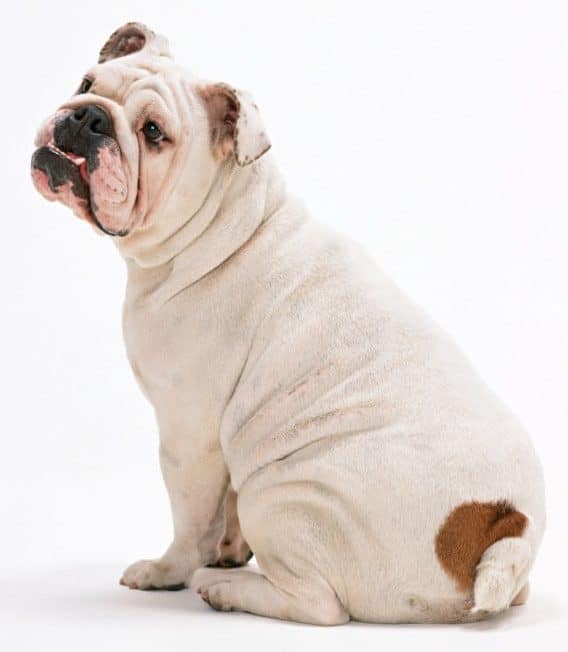
6. Distract and Redirect Bad Behavior
Continuing from training the “NO” command, your next job is to immediately distract your Bulldog and redirect the bad behavior to the correct behavior. Here are two examples:
- Discourage puppy biting and nipping. If your Bulldog pup bites you, let a high-pitched “OUCH!” and remove your hand out of the way. All puppies need to learn their bite inhibition (soft-mouth). In other words, they continue to develop what their mother and littermates taught them and gauge how hard they can bite before being disciplined. Redirect the puppy biting to something else, such as a chew toy.
- Stop destructive chewing. If your Bulldog likes to chow down on your wooden table leg or slippers, you need to teach him which things are okay to chew and which are not. Again, quickly distract him and redirect the unwanted behavior with a chew toy.
7. Use Positive Reinforcement
Reward-based training (positive reinforcement) will allow your Bulldog to associate good behavior with a reward and will help him to accept command associations such as “No” and “SIT.”
The best rewards for young puppies are training treats such as Zuke’s Puppy Naturals from Amazon. These are ideal for Bulldogs who are prone to weight gain, as they’re only 3.5 calories each.
However, here lies the “problem” with the “NO,” command. Firstly, waiting for your dog to mess up isn’t ideal for training him to drop whatever he is doing.
Secondly, you don’t want to reward your Bulldog so soon after he makes a Jackson Pollock painting from your living room couch!
So what’s the solution?
Teach your Bulldog the “NO” command by making him stop neutral activities. You can reward him after he drops off his chew toy, for instance. Similarly, you can teach him to stop running.
There are two points to consider: When he is actually behaving unacceptably, don’t immediately follow “NO” with a reward.
Instead, use the “NO” as a segue and make him follow a different command or behavior, preferably in a separate room/setting, after which you can give him his treat.
For instance, if he is busy turning toilet paper into confetti, you can use the “NO” command to get him to stop.
However, if you reward him immediately, he might associate it with being a canine toilet paper shredder!
Instead, you should take him to a separate room where you redirect his behavior to something else, such as making him sit or roll before you reward him. Thanks to his short attention span, he is not likely to associate the reward with his previously active mess.

8. Ignore Demanding Behavior
When disciplining your English Bulldog, there are some instances when you have to ignore his behavior.
One example is demand barking, which is when a dog learns that constant barking gets him what he wants, such as throwing a ball, going for a walk, or opening the treat tin.
90% of problem behaviors, such as unwanted barking, destructive chewing, digging, or separation anxiety, can be eliminated by ensuring your dog is sufficiently exercised, both mentally and physically.
Bulldogs require a moderate amount of exercise, and if you care and exercise them adequately, they will sleep or chill out in downtime.
Although ignoring your Bulldog’s demand barking will definitely work – as he’ll soon go off and do something else, it’s far easier to prevent it in the first instance by anticipating the behavior.
One way to do this is by ensuring you have a wide selection of toys handy, such as chew and puzzle toys.
I love the Outward Hound Dog Brick Interactive Treat Puzzle Toy, as it will keep your dog happy and engaged as he tries to find treats. Use the healthy, low-calorie treats I recommend above.
- BOREDOM BUSTER INTERACTIVE DOG TOY: As one of our most popular intermediate level 2 designs, the Dog Brick interactive puzzle includes additional obstacles and combinations of steps that will keep your dog focused and mentally-stimulated as they search and sniff out the tasty treats!
- FLIP, LIFT, & SLIDE TO HIDE TREATS: The Nina Ottosson Dog Brick comes with 3 types of treat hiding compartments to test your furry friends skills! Flip lid compartments open and slide to reveal two separate treat hiding spots while removable brick bones conceal the third hidden compartments in this puzzle dog toy.
- ENCOURAGES POSITIVE PLAY HABITS: This fun and rewarding puzzle is great for reducing anxious dog behavior and redirecting destructive behavior.
- BPA, PVC & PHTHALATE-FREE: Nina Ottosson by Outward Hound interactive treat dog puzzles are designed with your pets health in mind from food safe materials that you can trust with your dog. Easy to clean with warm water and soap between uses.
- PLAY IT SAFE: No toy is indestructible. Do not leave toys with unsupervised pets. Remove and replace toy if damag
Prices pulled from the Amazon Product Advertising API on:
Product prices and availability are accurate as of the date/time indicated and are subject to change. Any price and availability information displayed on [relevant Amazon Site(s), as applicable] at the time of purchase will apply to the purchase of this product.
Note: Clicking the above link(s) will take you to Amazon or an online store where we have an affiliate relationship. If you make a purchase, we may earn a commission at no additional cost to you.
9. Teach Your Bulldog to Accept Time-Outs
This is one of the most crucial steps in training your Bulldog, as it involves actual punishment.
Rewarding your Bulldog with treats is easy; it is in the punishment where most people mess up. You must teach your dog to follow your commands – or ground himself.
A time-out is a form of negative punishment in that we are taking away something the dog likes, in this case, social interaction.
Most dog owners might physically pick up their puppy and put him in a secluded area during a timeout.
However, that becomes harder and harder as your puppy grows. Though it might help your physical fitness to carry a progressively heavier canine dumbbell, you set yourself up for a battle (read the “do n’ts”), which isn’t good.
Instead, teach your Bulldog to follow your command, such as “GO” or “TIME-OUT,” and use that to get him into the area where you ground him. Here are some important things to remember when using effective time-outs:
- Time-outs should only last 60 seconds for young pups and no more than 2-3 minutes for older puppies.
- Segregate an area of the house or a room with a dog gate, or use an exercise pen.
- Remember to discipline at the moment of bad behavior, not after.
- Never put your pup in a room and close the door, which will create a negative experience.
- Never use your dog’s crate for time-outs – his crate is for sleeping and chill-out time.
Disciplining Your Bulldog: The Don’ts!
It’s impossible not to train your Bulldog because dogs are very observant and pick things up regardless of whether you’re intentionally educating them or are being yourself without any concern for what lessons you’re conveying.
Therefore, it is essential to know what the major disciplining mishaps are.
Don’t Start Too Late
If you do not know the appropriate time to start training your Bulldog, you might get him started too late on his path to being well-behaved.
The popular stereotype of Bulldogs being stubborn comes directly from misinformed owners not training their dogs soon enough.
Because owners assume that stubbornness is expected, they do not realize that they’ve started too late and continue to be forceful with their dogs (another “Don’t” addressed later)!
Most of this is because people think it is okay to start training their Bulldogs at four months old when they should begin at eight weeks.
The earlier training should be all about developing good habits. You should put yourself in the dominant position, not by being aggressive but by being caring and authoritative yet rewarding.
Bulldogs are mislabelled as aggressive because they can be aggressive if they want to.
To avoid aggressive behavior and pushback when training, you must train your dog to see you as a guide as soon as he is released to you at the 8-week mark.
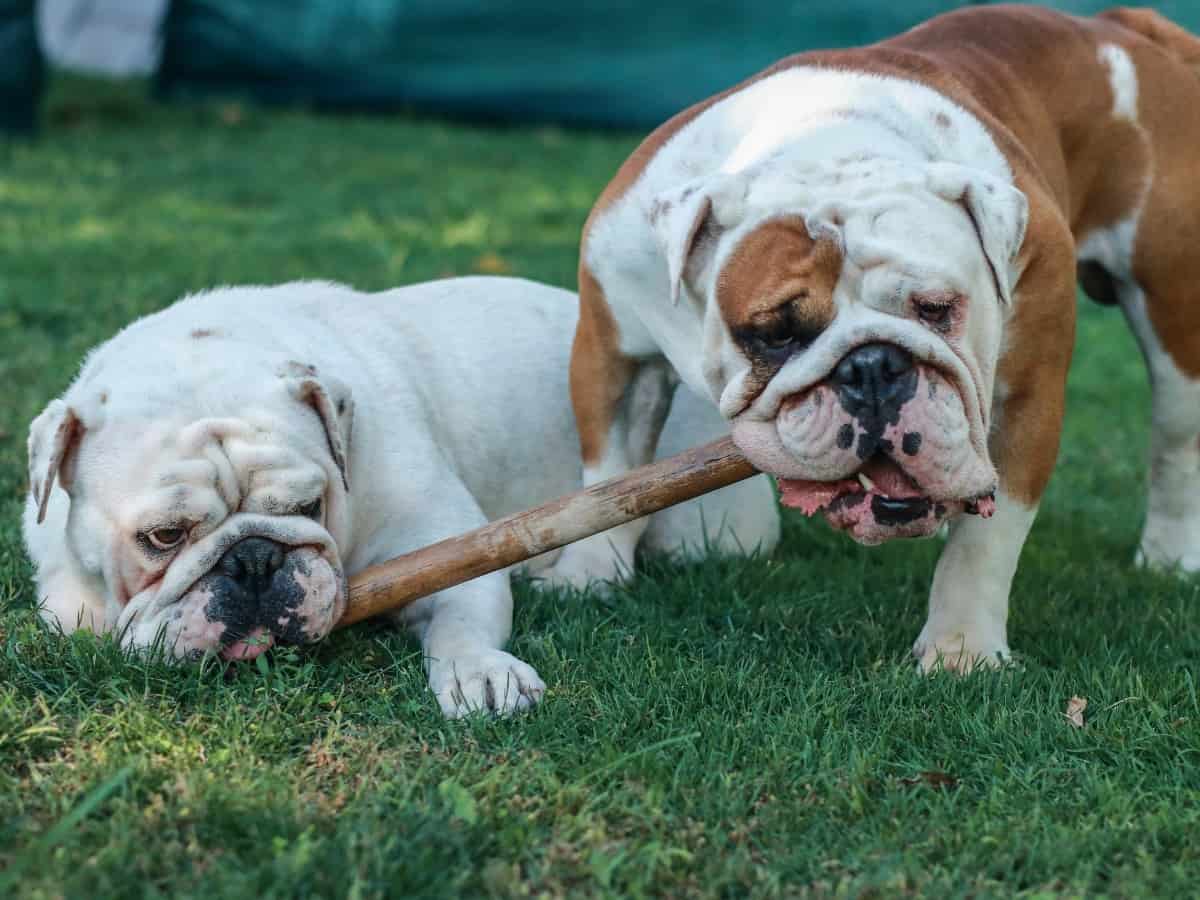
Don’t Push Too Much
Not all dog breeds are built alike, and if you’ve had a gentler dog before getting an English Bulldog, you might need to discipline your own discipline strategies.
Mellower breeds might be heartbroken over your harsh tone, but if you push a Bulldog too far, he won’t act like he got turned down at prom!
While Bulldogs do feel sad, they are more likely to get mad if you’re too aggressive in your “education.”
Remember Newton’s third law when training your Bulldog because, with them, every action indeed does have an equal but opposite reaction, especially if you try to force him into submission.
A Bulldog’s submission comes with trust and bonding. It helps to ground yourself and reset your perspective if your dog misbehaves.
Remember, you’re training him not so that things are easier for you; you’re training him so that he is fun and safe to be around, which is ultimately better for him. With this in mind, you’ll have more patience.
Don’t Use Force
If you cringe at reading the section heading, that’s good news. More dog owners need to be like you. However, using force doesn’t necessarily mean using physical punishment by hitting the dog.
Using force also means forcefully taking away toys or other things he bites on, tugging on his leash too hard, tying him up in the yard, using a shock collar, and even picking him up and taking him where he doesn’t want to go.
Dog owners do many of these unintentionally to their Bulldog puppies. After all, you’re not going to get your fully grown Bulldog to change positions by carrying him; that would be like deadlifting a barbell that can bite!
Using aversive techniques is one of the most common dog training mistakes.
Applying physical punishment will only cause your dog to fear you and lose trust. Studies have also shown that aversive-based methods harm dog welfare by causing stress and anxiety.
But when you use force on a smaller puppy, you’re training him that getting your way depends on physical punishment.
In other words, your Bulldog learns that he should listen to you only because you are stronger and are playing the bully. What do you think happens when he learns that you can no longer use your physical strength to restrain him?
Learn More on Why Not to Use Aversive Training Techniques…
Don’t Yell With Excessive Eye Contact
When your Bulldog makes a mistake, you might be tempted to express your disappointment the way you do when speaking to a naughty child.
However, children don’t possess 305 psi bite force, so you can get away with yelling and staring at them!
On the other hand, Bulldogs will not take aggressive eye contact positively as they perceive direct and prolonged staring as threatening and intimidating.
In some instances, you will see your dog avoiding eye contact. That should be your cue to stop. Your disappointment is registered. Knowing this alone will save you a lot of time.
To express disappointment, do not take on an angry tone. Instead, take a sadder tone. Since we started with the “Don’ts,” there’s a lot of caution around and discussion of dogs’ ability to bite. But don’t let that fool you.
Bulldogs care deeply about their owner – and knowing they have done something to upset you can make them feel bad.
Unfortunately, many dog owners do not take advantage of this cruelty-free method of disciplining a dog and choose to make their Bulldogs defensive, which leads us to yet another “Don’t.”
Don’t Make Your Bulldog Defensive
Bulldogs can get territorial and reactive if every educational step is considered a battle instead of a game or an exciting adventure.
For example, when playing fetch, you might be tempted to turn each round into a tug of war. But become uninterested when your dog refuses to give up the toy, stick, or ball and nudges him towards going easy without making it a battle.
Bulldogs are unfairly stereotyped as “dumb.” And while they are smart enough to function and stay popular as pets, they definitely aren’t smart enough to figure out how much damage they can do if they treat you like a peer.
That’s why it’s your responsibility to ensure your Bulldog never sees fighting with you, snatching from you, or pouncing on you as a game.
This normalizes defensive behavior in a gamified context, permitting him to harm you unintentionally.
Make sure to gamify things where his deference to your authority is the reward. It might not seem possible if you look at an average Bulldog, but with sufficient patience, you truly can position good behavior as a “victory” in every game.
After all, house training is exactly that: a gamified version of proper behavior. With Bulldogs, you have to extend similar training and patience to everything from being patient with the food bowl to being more focused on your walks.
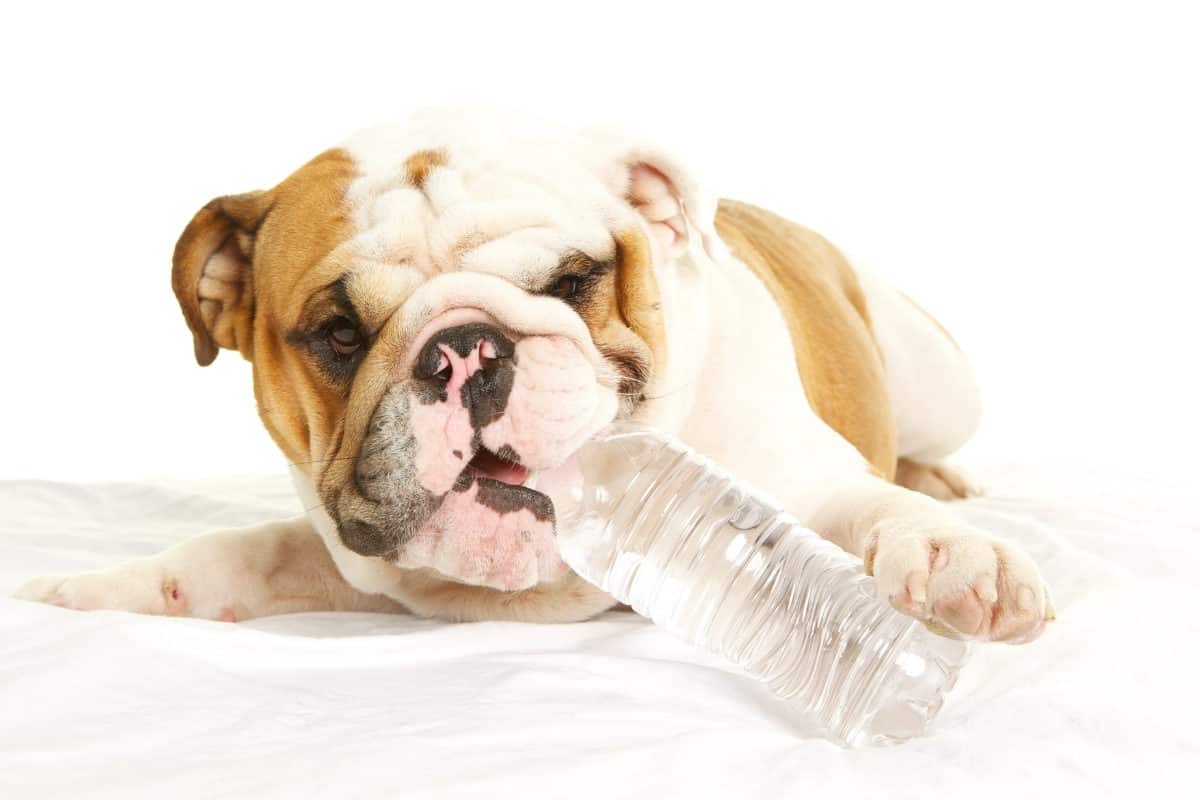
Don’t Be Too Passive
I know this might seem like mixed signals, but disciplining a Bulldog definitely is a tightrope walk.
While you can’t be aggressive and turn discipline into defeat by making everything a battle, you can not be so passive that your dog never learns to treat your commands as anything more than suggestions.
Being assertive, especially after establishing yourself as a leader, is possible without being aggressive. Channel your inner shaman and be the gentle guide.
You might hesitate because you’re wondering whether being assertive yet gentle would work with a Bulldog. It will if you start early and establish yourself as the dog’s sole source of treats!
Don’t Discipline Too Late
While you do your Bulldog a favor when you discipline him (in the correct way) for bad behavior, you cannot do so upon discovering said behavior, i.e., after the event. The problem with most dog owners is that they confuse finding a mess with making a mess.
If you see your dog making a mess, you can discipline him using the techniques later in the article.
However, if you discover a puddle he made at lunchtime during your dinner time, punishing him creates no association between the actual mistake and the punishment.
This is a classic mistake I certainly made years ago as a child when looking after my Gran’s chihuahua.
Back then, it was the done thing to discipline your dog if you came home and found he’d destroyed your socks! Or at least, that is what I was taught! So, why is this so wrong?
Let me explain.
Your Bulldog will associate being disciplined with whatever he did immediately before that moment, such as playing with his chew toy.
The discipline moment has been lost because dogs only have a short memory and will forget an experience in about two minutes. Instead, they learn by association.
Consequently, you won’t have a well-trained Bulldog, but only a confused dog who doesn’t understand why you’re angry at him for playing with his chew toy!
Later on, when he tries his chew toy, albeit hesitantly, and sees you encourage him and be happy, he will only grow to distrust the punishment before getting further confused about what you want from him.
Don’t Use Discipline to Get Even With Your Dog
This should go without saying, but it is only fair to mention it here because many dog owners do not even realize they’re doing this. When you punish your Bulldog too late, you only get even with him.
This, however, deserves a section of its own because you can displace your anger even when punishing your dog at the moment.
Whenever your Bulldog misbehaves, don’t ask, “what can I do to show disapproval?”
Ask yourself, “what can he see or hear to learn that what he did was wrong without getting defensive?” And with this prescriptive statement, we’re ready to get into actual “Do’s” for disciplining your dog.
Let’s Wrap This Up!
Bulldogs internalize and mirror the nature of their owners. Most owners expect some stubbornness in the breed, but you can preempt this by caring for and sufficiently exercising your dog.
By being patient and calm yet assertive and uncompromising, you can teach your dog to respect you and follow your commands.
When disciplining your Bulldog, stay calm, consistent, and patient, and never give up!






